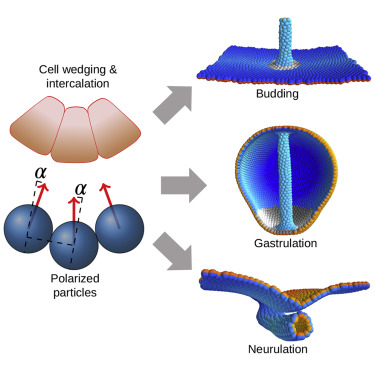iScience ( IF 5.8 ) Pub Date : 2020-01-11 , DOI: 10.1016/j.isci.2020.100830 Bjarke Frost Nielsen 1 , Silas Boye Nissen 1 , Kim Sneppen 1 , Joachim Mathiesen 1 , Ala Trusina 1

|
How do flat sheets of cells form gut and neural tubes? Across systems, several mechanisms are at play: cells wedge, form actomyosin cables, or intercalate. As a result, the cell sheet bends, and the tube elongates. It is unclear to what extent each mechanism can drive tube formation on its own. To address this question, we computationally probe if one mechanism, either cell wedging or intercalation, may suffice for the entire sheet-to-tube transition. Using a physical model with epithelial cells represented by polarized point particles, we show that either cell intercalation or wedging alone can be sufficient and that each can both bend the sheet and extend the tube. When working in parallel, the two mechanisms increase the robustness of the tube formation. The successful simulations of the key features in Drosophila salivary gland budding, sea urchin gastrulation, and mammalian neurulation support the generality of our results.
中文翻译:

将细胞形状和极性与器官发生联系起来的模型。
扁平的细胞片如何形成肠道和神经管?在整个系统中,有几种机制在起作用:细胞楔入,形成肌动球蛋白电缆或插入。结果,细胞片弯曲,并且管伸长。尚不清楚每种机制可在多大程度上自行驱动管的形成。为了解决这个问题,我们通过计算探索了一种机制,即单元楔入或嵌入,是否足以满足整个从板到管的过渡。使用具有由极化点粒子表示的上皮细胞的物理模型,我们表明,仅细胞插层或楔入就足够了,并且每个都可以弯曲板并延伸管。并行工作时,这两种机制可提高管结构的坚固性。果蝇关键特征的成功模拟 唾液腺出芽,海胆胃气化和哺乳动物营养支持了我们结果的一般性。



























 京公网安备 11010802027423号
京公网安备 11010802027423号